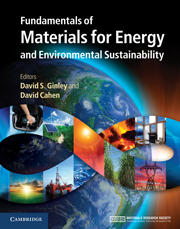Book contents
- Frontmatter
- Contents
- Contributors
- Preface
- Acknowledgments
- Part 1 Energy and the environment: the global landscape
- 1 A primer on climate change
- 2 The global energy landscape and energy security
- 3 Sustainability and energy conversions
- 4 Energy cost of materials: materials for thin-film photovoltaics as an example
- 5 Economics of materials
- 6 Global energy flows
- 7 Global materials flows
- 8 Carbon dioxide capture and sequestration
- Part 2 Nonrenewable energy sources
- Part 3 Renewable energy sources
- Part 4 Transportation
- Part 5 Energy efficiency
- Part 6 Energy storage, high-penetration renewables, and grid stabilization
- Summary
- Appendix A Thermodynamics
- Appendix B Electrochemistry
- Appendix C Units
- Index
- References
7 - Global materials flows
from Part 1 - Energy and the environment: the global landscape
Published online by Cambridge University Press: 05 June 2012
- Frontmatter
- Contents
- Contributors
- Preface
- Acknowledgments
- Part 1 Energy and the environment: the global landscape
- 1 A primer on climate change
- 2 The global energy landscape and energy security
- 3 Sustainability and energy conversions
- 4 Energy cost of materials: materials for thin-film photovoltaics as an example
- 5 Economics of materials
- 6 Global energy flows
- 7 Global materials flows
- 8 Carbon dioxide capture and sequestration
- Part 2 Nonrenewable energy sources
- Part 3 Renewable energy sources
- Part 4 Transportation
- Part 5 Energy efficiency
- Part 6 Energy storage, high-penetration renewables, and grid stabilization
- Summary
- Appendix A Thermodynamics
- Appendix B Electrochemistry
- Appendix C Units
- Index
- References
Summary
Focus
Human society requires increasing material inputs to sustain its production and reproduction. Many of the environmental problems we are currently facing can be attributed to this metabolism of society. This chapter explores the evolution of material use during human history and discusses current trends and patterns of global material consumption.
Synopsis
This chapter introduces the concept of social metabolism and the corresponding methodology of material flow accounting, which can be used to investigate exchange processes of materials and energy between societies and their natural environment and to address corresponding environmental problems. Against this background, the evolution of material use during human history from hunter-gatherers to current industrial societies is explored. The multiplication of global material extraction in the twentieth century, the shift from renewable biomass toward mineral and fossil materials and the growing share of materials used for non-energy applications are discussed in more detail. The chapter analyzes growth in material flows during industrialization and explores the interrelationships of material and energy use, population growth, economic development, and technological change. Inequalities in the global use of materials across countries and world regions are addressed. The chapter ends with a brief account of the challenges arising from the expected future growth of materials use.
- Type
- Chapter
- Information
- Publisher: Cambridge University PressPrint publication year: 2011

